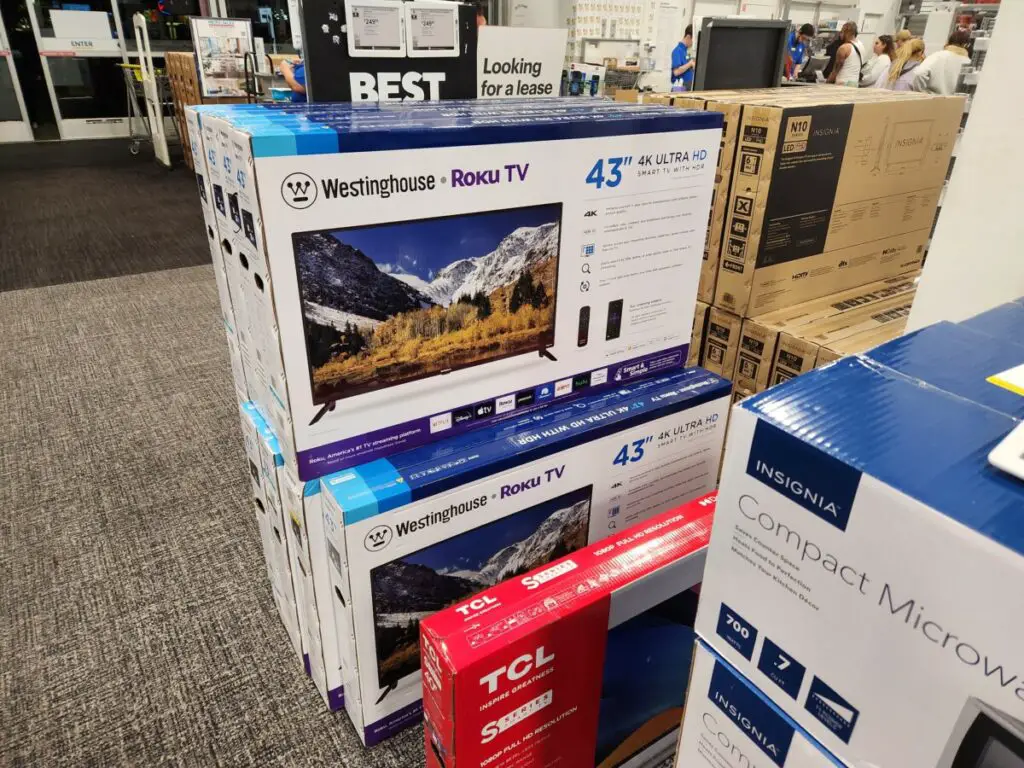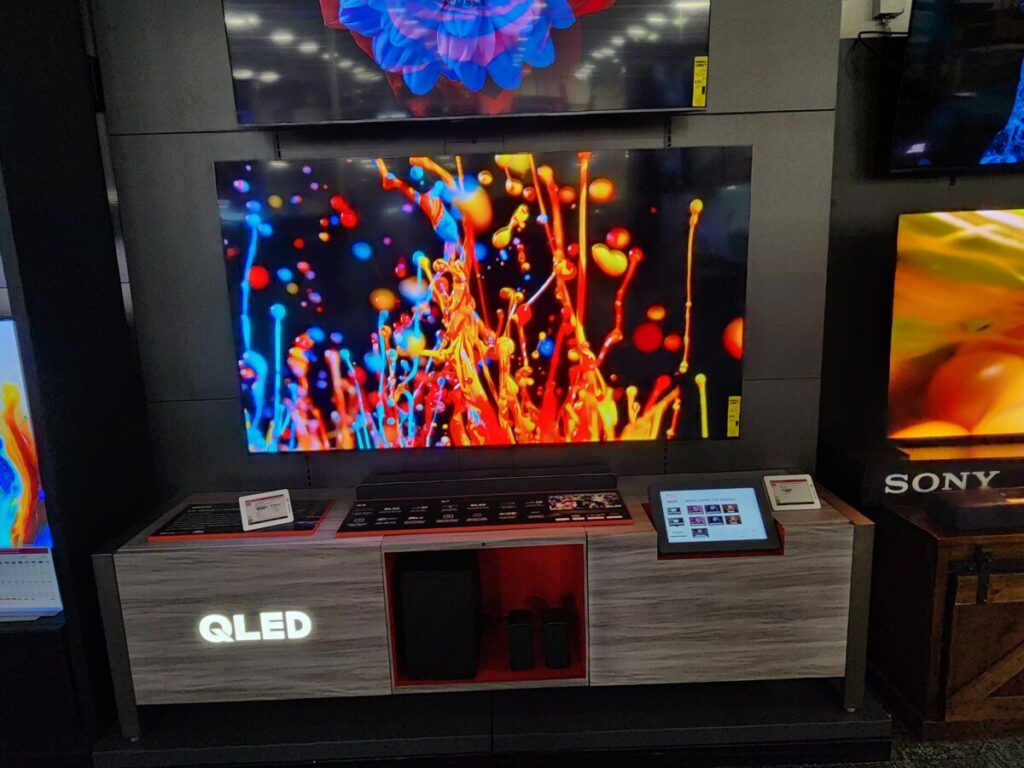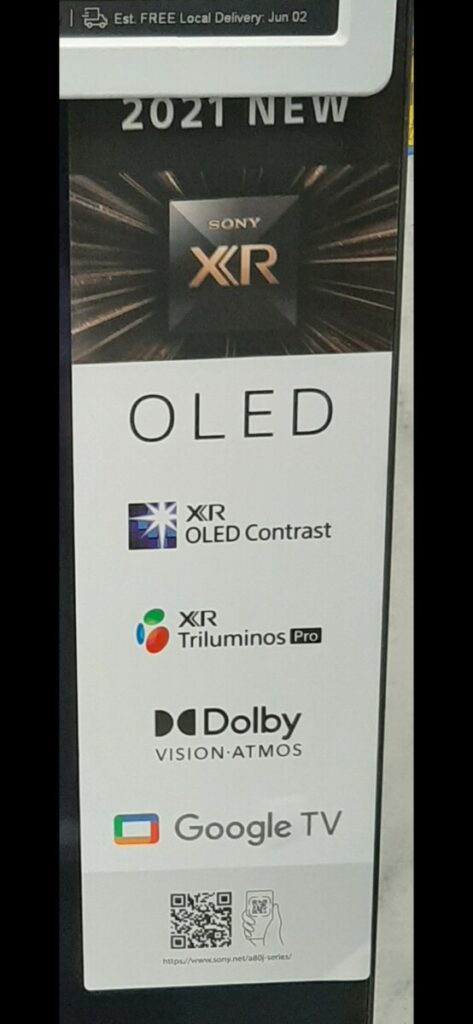As an Amazon Associate I earn from qualifying purchases
When shopping for a new TV, you might wonder if a smaller screen offers better picture quality compared to its larger counterparts.
It’s a common belief that smaller TVs provide a sharper and more detailed image.
This is partly due to their potential for higher pixel density, the same number of pixels packed into a smaller screen space, which can result in a clearer picture when viewed up close.
However, picture quality is influenced by several factors, including resolution, contrast ratios, and the technology behind the screen.
Modern advancements in TV technology have allowed even larger TVs to maintain excellent picture quality at the appropriate viewing distance.
The concept that smaller TVs inherently have superior picture quality doesn’t hold true across all brands and models.
It’s essential to consider how the resolution and the TV’s technology, like OLED or QLED, impact the overall viewing experience.
Ultimately, your choice depends on personal preference and the specific use case of the TV.
The optimal size and type for your home setup will vary based on the viewing distance, the room’s layout, and the content you enjoy.
Whether you pursue a compact TV for a small room or a large screen for a home theater experience, ensure that the television you select meets your expectations for picture quality and fits comfortably into your living space.
Do Smaller TVs Have Better Picture Quality?

The size of the TV does not inherently determine picture quality.
Factors like resolution, contrast ratio, and color reproduction are more crucial in impacting image sharpness and detail.
However, it’s important for you to know that when it comes to smaller TVs, particularly those under 43 inches, they are less likely to support advanced features such as 4K resolution and High Dynamic Range (HDR) that contribute to an excellent viewing experience.
For example, there are no 32-inch 4K TVs anymore.
Modern features that enhance picture quality tend to be more prevalent in larger TVs.
Smaller TVs are, therefore, more prone to offer lower resolution, meaning the pixels on the screen are larger and the image less detailed.
I recommend going with a 48-55 inch TV instead of a smaller 32-43 inch. There are great options available, here are just a few.
- 55 INCH 4K TV: Enjoy enhanced contrast, accurate colors, and fine details with our TCL 55-Inch Q6 QLED 4K Smart TV; Engineered with HDR PRO+ technology, including Dolby Vision, HDR10, HDR10+, and HLG for a breathtaking, vibrant picture quality
- QLED - QUANTUM DOT TECHNOLOGY: With over a billion colors, this 55 inch QLED TV showcases Quantum Dot Technology with UltraWide Color Gamut; With a HighBright Direct LED Backlight, our TCL QLED TVs produce brighter images for an enhanced viewing experience
- GOOGLE TV ENABLED: Experience UHD entertainment with Google Chromecast on this 55 inch smart tv; With the ability to cast directly from a mobile device, it offers a range of streaming services, bringing your favorite movies, shows, and live shows together
- MOTION RATE 240 AND MEMC FRAME INSERTION: Combining multiple motion enhancement technologies, this 4K UHD TV handles fast-paced scenes with ease; Breathing life into every image, our TCL 55 Inch TV ensures exceptional motion clarity
- GAME ACCELERATOR 120: Equipped with our Game Accelerator 120, this 120Hz TV provides a more responsive gameplay without lag; Also boasting a variable refresh rate powered by AMD FreeSync, this gaming TV is designed to keep you at the top of any leaderboard
SAMSUNG 55-Inch Class QLED 4K Q60C
- 100% COLOR VOLUME W/ QUANTUM DOT: Take in a billion shades of unwavering color and enjoy vivid, lifelike color at any brightness level as Quantum Dot technology works to create every shade you see on screen*
- QUANTUM PROCESSOR LITE W/ 4K UPSCALING: See shows and movies in a whole new light with 4K optimization; Enjoy enhanced clarity and depth in every scene as our Quantum Processor Lite with 4K Upscaling automatically transforms everything you
- DUAL LED: Don’t call it temperamental; You’ll enjoy beautifully balanced colors with dedicated warm and cool Dual LED backlights. Get stronger and accurate contrast with innovative technology that adapts automatically to match your content
- QUANTUM HDR: Watch the details shine through with Quantum HDR that goes beyond leading standards to create deep blacks, impressive contrast, and picture quality that’s analyzed and refined to match the creator’s vision
- MOTION XCELERATOR: Experience smooth motion and improved clarity with Motion Xcelerator; You can now fuel your need for speed with high intensity sports, movies, games, while enjoying crisp and clear details at the same time
- OBJECT TRACKING SOUND LITE: You’ll hear 3D surround sound that follows the movement on screen using our incredible virtual top channel audio—putting you right in the middle of the car chase, stampede or party scene
Hisense 55-Inch Class U8 Series Mini-LED ULED 4K UHD
- 4K ULED: Hisenses proprietary ULED technologies boost color, contrast, brightness, and motion.
- QLED QUANTUM DOT WIDE COLOR GAMUT: Quantum Dot QLED produces purer, richer, more brilliant and accurate color than a regular LED TV. Creating over a billion color combinations that bring vibrant images to life in a way non-QLED TVs cant
- Dolby Vision IQ & Dolby Atmos: Dolby Vision HDR picture and Dolby Atmos sound are cinema technology for your home. They provide amazing realism you can see and hear in every scene
Here’s the gist for you:
- Size Doesn’t Always Dictate Quality: Large or small, the actual picture quality is determined by technology like resolution and color fidelity.
- Advanced Features More Common in Larger TVs: Features like 4K and HDR, which greatly enhance picture quality, are typically found in TVs 43 inches and larger.
When choosing a TV, consider the display technologies available for the screen sizes within your interest, and assess which features are most important for your specific viewing needs.
Factors Influencing TV Picture Quality

When considering a TV’s picture quality, you should examine several technical aspects such as screen size, resolution, and viewing conditions.
These factors collectively contribute to your viewing experience.
Screen Size vs. Viewing Distance
Your viewing distance plays a critical role in determining the optimal screen size for your room.
As a general rule, the ideal distance from the TV is around 1.5 times the screen’s diagonal measurement for 4K resolution displays.
For instance, if you’re considering a 32-inch TV for your kitchen or a small room, you want to ensure that you can sit close enough to appreciate the detail without being overwhelmed by the size of the screen.
Pixels Per Inch (PPI) and Pixel Density
Pixel density, often measured in pixels per inch (PPI), directly impacts picture sharpness.
A higher PPI means more pixels are packed into each inch of the screen, resulting in a clearer and more detailed image.
Small TVs tend to have higher PPI because they often maintain a high resolution despite a smaller size.
Therefore, a 32-inch TV with a 4K resolution will have a greater pixel density than a larger TV with the same resolution.
Viewing Angle and TV Placement
The quality of your TV’s picture can also change depending on your viewing angle.
Most TVs have a specific range where the picture quality remains optimal. When you move outside this range, the colors and contrast can appear to degrade.
Your TV placement is essential to ensure you maintain a viewing angle that does not compromise your experience, especially in wider rooms where viewers may be spread out.
Understanding TV Technology and Picture Quality

When you’re looking to purchase a new TV, understanding the technology and features that contribute to picture quality is essential.
This will help you make an informed decision and select a TV that meets your viewing preferences.
Display Technologies: LED, OLED, and QLED
LED TVs use light-emitting diodes to illuminate the display, providing good contrast and brightness.
OLED, or organic light-emitting diode displays, create impressive color contrasts by producing light per pixel rather than using a backlight.
This technology, found in TVs from brands like LG and Sony, allows for true blacks and a high dynamic range.
QLED TVs, like those from Samsung, utilize quantum dots in conjunction with LED backlights to enhance color and brightness further.
OLED is the gold standard but it is expensive and mostly optimal for dark rooms. QLED makes more sense for most living situations at has a brighter display.
QLED is also significantly cheaper than OLED.
Resolution Explained: From 1080p to 4K and Beyond
Resolution refers to the number of pixels that make up the display.
1080p, also known as Full HD, has been the standard, offering a resolution of 1920×1080 pixels.
The jump to 4K, or Ultra HD, brings a resolution of 3840×2160 pixels, significantly increasing pixel density and providing a sharper image.
4K can potentially become the standard technology in the years to come.
As technology progresses, resolutions beyond 4K, such as 8K, are emerging, offering even greater detail and clarity.
However, 8k is overkill and it doesn’t seem that it’s being adopted as expected.
The Role of Contrast, Brightness, and Color in Image Quality
Contrast is the difference between the darkest and brightest parts of the picture, and a higher contrast ratio means more detail.
Brightness in a display affects the visibility of the image, especially in well-lit conditions.
Color accuracy, including color temperature and the range a TV can display, contributes to the realism of the image.
Technologies like HDR, or high dynamic range, enhance these attributes, making for a picture quality that’s more vibrant and lifelike.
Performance Considerations for Specific Viewing Needs

Choosing the right TV involves understanding how different features impact performance for your specific viewing needs.
Whether you’re gaming, following live sports, or seeking an enriched audio-visual experience for movies and shows, the right TV can significantly enhance your enjoyment.
Gaming TVs: Low Input Lag and Variable Refresh Rate
For gaming, especially on consoles like the PS5, what you need is a TV that minimizes input lag and has a high variable refresh rate.
Low input lag ensures that the time delay between pressing a button on your controller and seeing the result on screen is imperceptible, crucial for fast-paced games.
A gaming-friendly feature, Variable Refresh Rate (VRR), keeps the action smooth and free from screen tearing.
Some reliable choices include TVs from Hisense and TCL.
Best TVs for Watching Sports and Live News
When it comes to watching sports or live news, motion handling is crucial.
For an immersive experience, look for TVs with a high refresh rate that can display the fast action of sports clearly.
Sizes like a 55-inch or 65-inch UHD set can deliver an excellent balance between size and detail, making sure you don’t miss any of the action.
Brands like Vizio and Samsung’s The Frame offer great value and performance for sports enthusiasts and news followers alike.
Audio and Smart Features for an Enhanced Experience
Finally, your TV’s audio capability and smart features can greatly enhance your experience.
Integrated smart platforms like Google TV or Fire TV offer convenience and a multitude of streaming options, accessible via Wi-Fi.
Insignia and Vizio TVs combine crisp Ultra HD video with clear audio that can be further expanded with soundbars. Look for models with built-in Alexa for easy voice control to elevate your user experience.
By considering these specific features in relation to what you prioritize, be it gaming, sports, news, or streaming, you will be able to choose a TV that delivers excellent picture quality and meets your entertainment needs whether you opt for bigger or smaller TVs.





